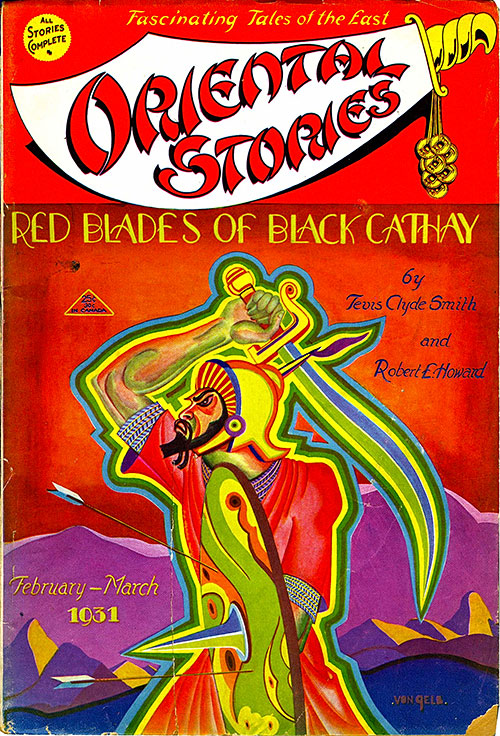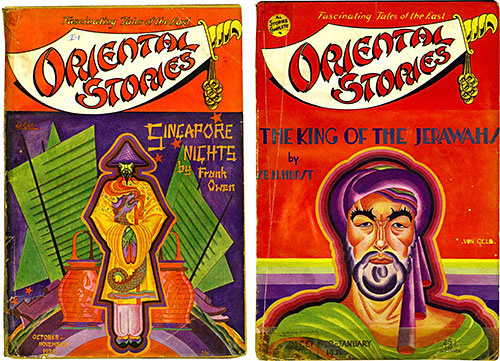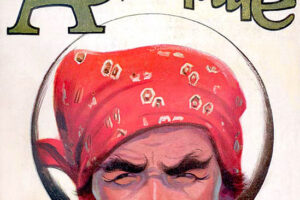The first three covers of Oriental Stories must have almost jumped off the newsstand for someone browsing for reading material in late 1930 and early ’31.
They are bright, rainbow-colored and visually unlike any other pulp cover.
Popular Fiction Publishing Co. introduced Oriental Stories with the October/November 1930 number as a companion to its seven-year-old Weird Tales. (Popular Fiction shouldn’t be confused with Harry Steeger‘s Popular Publications, later publisher of The Spider, which also introduced its first pulps in late 1930. Popular Fiction was actually an offshoot of Chicago’s Rural Publications.)
Weird Tales shared its editor, Farnsworth Wright, with Oriental Stories. The two pulps also shared a number of fictioneers, including Robert E. Howard, Frank Belknap Long, Otis Adelbert Kline and E. Hoffmann Price.
Oriental Stories continued for nine issues, when its name changed to Magic Carpet. Magic Carpet ran for another five numbers before folding.
Back to the cover for the February/March 1931 number of Oriental Stories (below)… the logo is typical in a pulp-ish graphical way, but the cover painting stands out.

It’s signed “von Gelb,” for Donald von Gelb. It doesn’t appear von Gelb contributed to any other pulp, but he’s credited to just the first five issues of Oriental Stories.
Terence E. Hanley over at the Tellers of Weird Tales blog gives von Gelb’s name as simply Donald Gelb. It’s possible that this is the same “Don Gelb” who served as art director for Bantam Books in the early 1950s. (He was replaced in 1955 by Len Leone, who had a great influence in Bantam’s reprinting of the Doc Savage stories.) Don Gelb was also an agent for illustrator Robert McGinnis in the late 1950s.

In trying to describe von Gelb’s cover style for the first three Oriental Stories (the first two numbers are pictured above), all I could come up with was Art Deco. But that didn’t satisfy me. So I turned to pulp art expert David Saunders (son of pulp artist Norman Saunders). Here’s what he said:
The term “Art Deco” is the simplest general category, and that art movement was most popular at that time period, as well as the tendency of Art Deco to use decorative over-embellishment along with flat graphic colors. However, the Art Deco movement expressed an adoration of modernistic streamlined machinery. Artists of the Art Deco movement philosophically embraced the industrial revolution and the “Machine Age” in admiration of man’s inventive genius. Although there may be plenty of exceptions, we usually associate Art Deco artists with subjects that exemplify speedy vehicles, Glamour Queens, and sleek machines. so the fact that von Gelb was concerned with subjects that are not at all “modern,” such as mystical ancient warriors, biblical kings, and Asian mythology, it might seem misleading to simply call him an Art Deco artist.
On the other hand, another important art historical “style” that is concerned with subjects that are most closely related to those covers by von Gelb for Oriental Stories is the style known as Coptic Art, which dates from early Christianity. Coptic Art looked a lot like this and was concerned with the identical subject matter, kings and warriors and avenging arch-angels. By the way, both Pablo Picasso and Francis Picabia independently claimed their art was significantly influenced by their admiration for Coptic Art, there were some fans of Coptic Art among the modernists.
If one were to flatly state without qualification that these 1930 covers by von Gelb for Oriental Stories are only “Art Deco” then one might be making a misleading statement, because the subject matter and the style is largely evocative of Coptic Art. So it might be too wordy, but a more accurate art historical phrase to describe those 1930 covers by von Gelb for Oriental Stories might be, “an Art Deco version of Coptic Art.”
Odd sounding but perhaps a more accurate description of this unique amalgam.
Whatever it’s called, you can call it Great Pulp Art.



